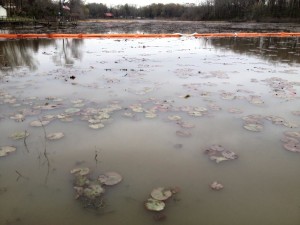We have much more to do and your continued support is needed now more than ever.
U.S. Department of Justice and Arkansas Attorney General Move to Penalize ExxonMobil
As the saying goes, an ounce of prevention is worth of pound of cure.

The various state violations are subject to civil fines ranging from $10,000 to $25,000 a day, while the federal Clean Water Act violations carry fines up to $4,300 per barrel of oil spilled. Depending on how these fines are assessed, they could be pretty hefty. The complaint details the severe and long lasting water quality problems this spill has created to nearby streams and wetlands – impacts that will scar these waters use by people and wildlife for a long time to come.
These alleged violations come as no surprise from a company that is not a stranger to facing legal actions for spilling oil. Exxon is the company that brought us the infamous ExxonValdez disaster. And on its 2010 pipeline spill into the Yellowstone River, the company is now challenging the $1.7 million in penalties it was assessed for failing to take proper safety measures to prevent this massive spill that contaminated 70 miles of the iconic western river. ExxonMobil is a company that earned almost $10 billion of profit last year. Yet it unapologetically fights a relative slap on the wrist fine. Clearly, Exxon’s leadership prioritizes money over people, and fails to see that these fines are meant to scold them into behaving responsibly.
Which brings us to the question of prevention:
Why doesn’t the Administration move to stop these tar sands pipeline spills from happening in the first place? It could do so in at least two ways. Here’s how:
First, transporting tar sands is simply too risky and current safety regulations are inadequate. Not only can industry not be trusted to follow the law; the law doesn’t properly protect us. Tar sands is a corrosive material with a higher acid number, and is more abrasive than conventional oil. It needs to be transported at higher temperatures and pressures than regular oil, which studies have shown produce higher risks of spills. And when it does spill, as we’ve seen in both Arkansas and the July 2010 Kalamazoo spill, it sinks to the bottom of waterways, proving nearly impossible and very expensive to clean up.
Numerous groups, landowners and concerned current and former state officials have petitioned the Environmental Protection Agency and Pipeline Hazardous Materials Safety Administration – the federal agencies charged with regulating pipeline operation and response – to implement rules that would adequately protect communities and resources from tar sands transit and spills. Currently, regulations treat all tar sands and regular oil the same, despite the fact that EPA has acknowledged the challenges of dealing with tar sands spills have not been figured out. Until we learn how to address tar sands safety risks, we shouldn’t be transporting more of it.
But the best way to stop tar sands spills is to stop tar sands development. Tar sands pipelines spur tar sands development, which is extremely carbon intensive and puts our climate at risk. While ExxonMobil CEO Rex Tillerson might think of climate change as an “engineering problem,” the preview we’re getting of what’s in store looks more like a horror show. Superstorm Sandy cost us $60 billion, we are entering yet another season of extreme and devastating wild fires in the West – something that may become a terrifying and expensive norm – and it’s a good thing the first game of the Stanley Cup finals went into triple overtime, because during the game the Midwest was experiencing a severe storm reminiscent of last year’s derecho that made conditions too dangerous for the fans to leave the arena and head home, not to mention the billion dollars of damages it caused.

He also is facing a decision as to whether to approve the expansion of a tar sands pipeline, the Alberta Clipper, which cuts through the Upper Great Lakes from 450,000 bpd to 880,000 bpd – something that would enable more tar sands to flow under treasures like the Straits of Mackinaw.
He is likely to face a decision to allow tar sands to travel through an existing ExxonMobil pipeline in New England that is about the age and size of the Pegasus line – a line that flows by Sebago Lake, one of the most pristine freshwater lakes in the U.S. and supplies 200,000 Mainers with drinking water, along with other treasured resources in Northern New England.
Tar sands pipelines are too risky. They are a huge step in the wrong direction. We can’t afford the massive climate impacts of tar sands development. We can’t afford to put resources like the Great Lake, Ogallala aquifer, Mississippi River, Casco Bay and countless other resources. President Obama needs to reject these pipelines. It’s time to say no to dirty fuels and aggressively move to clean energy solutions. The time for prevention is now. The cost of cure is too expensive to bear.





















